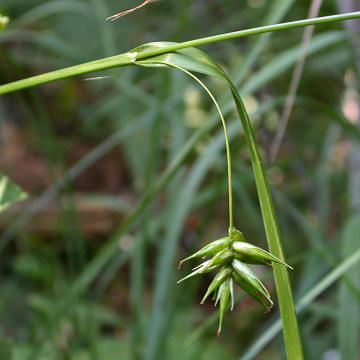

Carex folliculata - (image 1 of 6)
Taxonomy
Family: Cyperaceae
Section Rostrales
Habitat
Wet woods and meadows, swamps.
Associates
Distribution
Newfoundland and Quebec to WI, south to FL and LA.
Morphology
Perennial to 1 m or more, forming large clumps. Leaves 4-16 mm wide, yellow green; bract sheaths prolonged at the mouth; terminal spike staminate, to 2.5 cm long, peduncled; pistillate spikes 2-5, separate, erect, subglobose, 1.5-3 cm, the lower on long peduncles, upper on shorter peduncles; bracts leaf-like, to 8 mm wide, surpassing the stems; perigynia slenderly subulate, 10-15 x 2-3 mm, gradually tapering into beak, teeth erect to merely spreading; style persistent on the achene, becoming bony or cartilaginous; achene trigonous; stigmas 3.
Notes
Fruiting June to July
Wetland indicator: OBL
In botany a follicle is a type of fruit that opens at maturity along a single seam. Perhaps to Linnaeus the perigynia looked a bit like the follicles of members of the dogbane family (milkweed, indian hemp).
References
Gleason, Henry A. and A. Cronquist. 1991. Manual of Vascular Plants of
Northeastern United States and Adjacent Canada. Second Ed.
The New York Botanical Garden. Bronx, NY
Swink, F. and G. Wilhelm. 1994. Plants of the Chicago Region.
Indiana Academy of Science. The Morton Arboretum. Lisle, Illinois.
|
© Michael Hough 2010 |